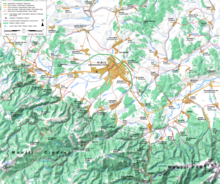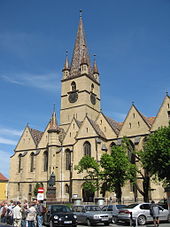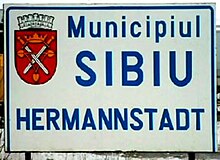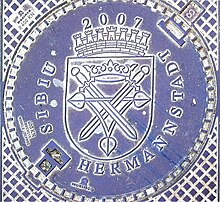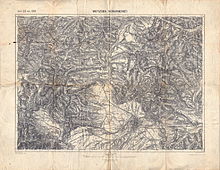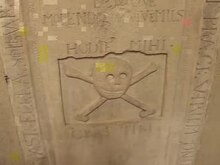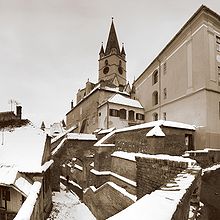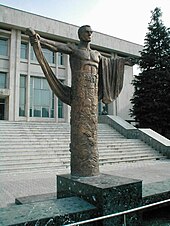Sibiu
|
Sibiu Hermannstadt Nagyszeben |
||||
|
||||
| Basic data | ||||
|---|---|---|---|---|
| State : |
|
|||
| Historical region : | Transylvania | |||
| Circle : | Sibiu | |||
| Coordinates : | 45 ° 48 ' N , 24 ° 9' E | |||
| Time zone : | EET ( UTC +2) | |||
| Height : | 431 m | |||
| Area : | 121 km² | |||
| Residents : | 147,245 (October 20, 2011) | |||
| Population density : | 1,217 inhabitants per km² | |||
| Postal code : | 550003-550550 | |||
| Telephone code : | (+40) 02 69 | |||
| License plate : | SB | |||
| Structure and administration (as of 2016) | ||||
| Community type : | Municipality | |||
| Mayor : | Astrid Fodor ( DFDR ) | |||
| Postal address : | Str. Samuel Brukenthal No. 2 loc. Sibiu, jud. Sibiu RO-550178 |
|||
| Website : | ||||
Hermannstadt ( Romanian Sibiu [ si'biu ], Hungarian Nagyszeben , Transylvanian-Saxon Hermestatt ) is a city in the Sibiu district in the Transylvania region in Romania and was together with the city of Luxembourg European Capital of Culture in 2007 .
geography
location
The city lies on the Zibin , a tributary of the Alt , near the Southern Carpathians . Other waters in the city are the Reußbach / Pârâul Reussbach / Pârâul Rusciorului, the Trinkbach / Pârâul Trinkbach and the Seifenbach / Pârâul Săpunului, the Schewiskanal / Canalul Sevis and the Bindersee / Lacul Binder . South of the city extends the mărginimea sibiului , a traditional Romanian inhabited region of Podkarpacie . To the north, northwest, northeast, southwest and east of the city is the former " Königsboden " - the area historically inhabited by Transylvanian Saxons .
climate
In the city there is a continental climate of temperate zone . The annual average temperature is 9 ° C. In July the temperature is 20 ° C and in January it is −4 ° C. Thus the temperature amplitude of 24 ° C for the 46th parallel is relatively high, which can be explained by the location at the foot of the Carpathian Mountains and the great distance to the sea. The amount of precipitation in Sibiu is 652 mm per year. The months from December to March have the least rainfall, at 30 mm each. In June, however, there is the most rainfall of the year with 118 mm. The climate is therefore humid all year round .
| Sibiu | ||||||||||||||||||||||||||||||||||||||||||||||||
|---|---|---|---|---|---|---|---|---|---|---|---|---|---|---|---|---|---|---|---|---|---|---|---|---|---|---|---|---|---|---|---|---|---|---|---|---|---|---|---|---|---|---|---|---|---|---|---|---|
| Climate diagram | ||||||||||||||||||||||||||||||||||||||||||||||||
| ||||||||||||||||||||||||||||||||||||||||||||||||
|
Average monthly temperatures and rainfall for Sibiu
Source: wetterkontor.de
|
|||||||||||||||||||||||||||||||||||||||||||||||||||||||||||||||||||||||||||||||||||||||||||||||||||||||||||||||||||||||||||||||||||||||||||||||||||||||||||||||||||||
Historic landscape
In Transylvania, Sibiu was the main center in the most important settlement area of the Transylvanian Saxons. The Sibiu Chair was also the largest in terms of area. It extended in the south to the Carpathian Mountains and in the north also included exclaves in the Kokel region ( Bulkesch and Seiden ). It was bordered (from east to north to west) by the Leschkirch , Mediasch and Reussmarkt chairs . This is where the most important trade routes in Transylvania and the Rotenturm Pass in the direction of Wallachia meet. The location at this crossroads was of outstanding importance for the city, but it also repeatedly made it the target of violent attacks.
City structure
The urban area is subject to constant expansion, which is recorded in a ten-year development plan , the Plan Urbanistic General (PUG). According to the PUG of 1999, the city is divided into several quarters ( Romanian cartiere ), zones ( zone ) and sub-zones ( subzone ). a. classified as residential , industrial or special area. In 2009 work began on a new development plan, which was approved on April 27, 2011.
|
|
|
Neighboring communities
The neighboring communities belonging to the district are Heltau ( Cisnădie ), Großau ( Cristian ), Rothberg ( Roșia ), Schellenberg ( Șelimbăr ), Großschubbing ( Șura Mare ) and Kleinschubbing ( Șura Mică ).
history
The first German settlers probably reached the area in 1147; they settled on the hill above the Zibin River, today's Upper Town. The first written mention comes from the year 1191 under the name praepositum Cibiniensem ; a provost's office was established. From 1223 the Latin name "Villa Hermanni" and from 1241 the German equivalent Hermannstorf is documented. The name is probably derived from the name of the Cologne settlers, who named their new place after Archbishop Hermann II or a locator named Hermann.
Benefiting from its location at the intersection of two important road connections, the settlement grew rapidly and had 600 residents, a size that was already considerable for a village at the time. It is believed that the original settlement and the church at that time were already fortified with ramparts or palisades. In 1241 Hermannsdorf, like many other places in Transylvania, was destroyed in the Mongol storm.
However, the village was soon able to recover from the destruction and subsequently developed into a town. However, express city law can only be adopted from the middle of the 14th century. The name Sibiu was mentioned for the first time in 1401, although it was certainly in use before. The coat of arms of Sibiu dates from the same time. In the 14th century Sibiu also developed into a trading center of international importance. It was one of the most important cities in Transylvania - perhaps the most important, as it was not only a center of trade, administration and church, but also had the largest fortifications in all of Transylvania.
In 1438 the Turks besieged the city, but did not succeed in taking the city. In contrast, the entire surrounding area was devastated. As a result of the threat from the Turks , the city had three wall rings (some of which are still preserved) with 39 towers and several large gates built. It became the largest fortified city in the Kingdom of Hungary . Sibiu resisted several sieges by the Turks, who never succeeded in taking the city. In 1445 Pope Eugene IV therefore called Sibiu the wall and shield of Christianity . However, the armies passing through and encamped in front of the city devastated the entire surrounding area again and again. Only once did the Hungarian prince of Transylvania, Gabriel Báthory , use a ruse to occupy the city, plunder it and expel all German residents from the solid walls - a bitter lesson that subsequently led to even greater vigilance and distrust on the part of the Germans.
By 1500 Sibiu already had about 6000 inhabitants. During the Reformation , writings by Martin Luther and Philipp Melanchthon came to the city from 1523 . In 1543 the evangelical creed was introduced because the estates had given each other free choice of faith. On March 31, 1556, the entire lower town and part of the upper town burned down in a town fire. Around 550 buildings were destroyed.
Sibiu was the political center of the Transylvanian Saxons and the seat of the Universitas Saxonum , a kind of Transylvanian parliament that dealt with Transylvanian-Saxon matters until 1878 and was a symbol of the political unity and independence of the Transylvanian Saxons.
In 1692, after Transylvania was annexed to Austria , imperial troops settled in the city. General Damian Hugo von Virmont supported the construction of the Jesuit church on the Great Ring and the return of the Franciscan monastery . In 1781, by a decree of Emperor Joseph II, the old laws, according to which no members of other nations were allowed to settle in the city, fell. This enabled Hungarians and Romanians to acquire property within the city walls. First of all, Gergely Bethlen's widow had a late baroque palace built next to the reformed rectory in Fleischergasse, known today as “The House with Caryatids”. As a result, the Romanians were also able to build churches in the city for the first time, for example the Biserica din Groapă and the Biserica dintre Brazi in 1788 . In the 18th century, Sibiu enjoyed, among other things, the reputation of being the easternmost city in Europe with a postal connection.
In the Austrian Empire, Sibiu was under the imperial-royal (k. K.) Government in Vienna until 1867, like all of Transylvania . When it was reorganized into the Austro-Hungarian Dual Monarchy , it became part of the Kingdom of Hungary, Transleithanien , and was now under the royal government in Budapest until 1918 . She endeavored to Magyarize the non-Magyar nationalities of the kingdom, then about half of all residents of Transleithania.
After the First World War , the Romanians of Transylvania decided on December 1, 1918 in Alba Iulia (Karlsburg) to join Romania, which in fact took place very quickly. The Transylvanian Saxons and other Transylvanian Germans supported this because they (in vain) expected better minority rights in Romania. In the Treaty of Trianon, the victor of war with Hungary, it was fixed in 1920 against the protest of the Magyars that Transylvania and Sibiu would remain with Romania. Even after that, the city remained German. Only at the end of the 1930s did the Transylvanian Saxons lose an absolute majority in their metropolis.
In 2017, Sibiu was awarded the honorary title of “ Reformation City of Europe ” by the Community of Evangelical Churches in Europe .
population
The population is around 147,000 and developed as follows:
| census | Ethnic composition | |||||||
|---|---|---|---|---|---|---|---|---|
| year | population | Romanians | Hungary | German | other | |||
| 1850 | 12,765 | 2,089 | 977 | 8,790 | 909 | |||
| 1920 | 32,748 | 8,553 | 4,291 | 18,218 | 1,686 | |||
| 1930 | 49,345 | 18,620 | 6,521 | 21,598 | 2,606 | |||
| 1941 | 63,765 | 33,829 | 4,262 | 23,574 | 2,100 | |||
| 1956 | 90,475 | 59,855 | 4,882 | 24,253 | 1,485 | |||
| 1977 | 151.005 | 119.507 | 5.111 | 25,403 | 984 | |||
| 1992 | 169.160 | 158,863 | 4.163 | 5,605 | 979 | |||
| 2002 | 154,841 | 148.218 | 3.135 | 2,508 | 980 | |||
| 2011 | 147.245 | 139.998 | 2,169 | 1,561 | 3,517 | |||
The population of Sibiu peaked in 1992 and has been falling since then. In particular, the number of German residents decreased rapidly after 1989, as many left Romania for Germany. In addition to Romanians, Hungarians, Germans and Roma , individual Ukrainians , Serbs and Slovaks were also recorded in almost every census .
Germans in Sibiu
At the end of 2007, 1427 Germans of Protestant denomination lived in Sibiu , that is a total of around 2000 German residents (1.6%) in the city.
Until the Romanian Revolution in 1989 , despite massive emigration, around 20,000 Transylvanian Saxons lived in Sibiu since the mid-1970s. Their share of the population fell rapidly and steadily after 1990 until it fell behind that of Hungarians at around 1.6%. The town signs and tourist information are labeled in Romanian and German. Officially, the city is now run as Sibiu / Hermannstadt. In 1992 the German-Romanian Foundation Sibiu was established.
The German-language Hermannstädter Zeitung appears weekly. There are German kindergartens, elementary schools, several grammar schools with German as the language of instruction (mother tongue), including the Brukenthal-Lyzeum , where a German-language Abitur is possible, which is recognized by German universities. There is also the educational lyceum as a training center for German-speaking educators and future teachers. German is the language of instruction at a total of four secondary schools (lyceums). German-language courses can be taken at the city university. There is also an evangelical-theological German faculty in which the evangelical church A. B. in Romania trains its pastors. There is also the Evangelical Academy of Transylvania (EAS) in Neppendorf , as well as a retirement home ( Carl-Wolff -Altenheim), which was built by the German government to stabilize the German minority in the early 1990s and is now under the sponsorship of Dr.-Carl -Wolf Club is operated.
There are also three private German-language publishers ( Honterusverlag , Hora Verlag and Schiller Verlag ), which regularly publish new publications, and a printing company ( Honterus-Druckerei ) owned by the German minority, which produces according to Western standards.
In addition, after the exodus of the majority of the Transylvanian Saxons, important works of art, cult dishes, church books, registers, tomes, papers, etc. v. m. Moved from the disbanded Protestant communities and abandoned villages to the episcopal archives, camps and libraries, compiled and saved. The central archive of the German minority with a large inventory of historical materials and documents is located in the “ Friedrich Teutsch ” culture and meeting center . The holdings have been processed and archived for years and the archive is supported by the Volkswagen Foundation. The regional church museum of the Evangelical Church A. B. in Romania is also located there. In addition, the district consistory of the church district of Sibiu and the Protestant bishop Reinhart Guib are resident in the city.
The city was ruled by Klaus Johannis for 14 years from 2000 . The Democratic Forum of Germans in Romania has had an absolute majority in the city council since 2004 . This fact is u. a. attributed to the fact that so many direct investments from German-speaking countries went to Sibiu in recent years. In this context, around 100 German managers (some with families) are permanently in the city and now form a small community of expatriates .
European Union
Together with Luxembourg (City) , Sibiu was named European Capital of Culture for 2007 by the then 25 EU culture ministers. Attempts to have the old town entered on the UNESCO World Heritage List have so far failed. However, the city made great efforts to promote the renovation of the old town. The results are u. a. the complete redesign of the Großer Ring (the central square of the old town), the Kleiner Ring and the Heltauer Gasse. Important historical buildings have been and are being renovated with funds from the EU, German federal funds and Romanian state funds.
In May 2019, 27 heads of state and government of the European Union met in Sibiu. They adopted a declaration on basic values for future cooperation.
Religions and denominations

| Multi-confessional Sibiu | ||
|---|---|---|
| Denomination | 1910 | 2000 |
| Romanian Orthodox | 18% | 91% |
| Greek Catholic | 8th % | 1 % |
| Roman Catholic | 20% | 2% |
| Protestant A. B. | 42% | 2% |
| reformed | 7% | 1 % |
| Jewish | 4% | <1% |
| Others | 1 % | 4% |
After: "Sibiu - Portrait of a City in Transylvania"
In 2007 the Third European Ecumenical Assembly took place in Sibiu ; the first took place in 1989 in Basel and the second in 1997 in Graz . These gatherings are occasions that churches of different Christian denominations in Europe hold together in order to promote unity and ecumenical cooperation between churches of different traditions.
politics
Astrid Fodor ( Democratic Forum of Germans in Romania ) was elected first mayor on June 5, 2014 , after Klaus Johannis was elected President. Klaus Johannis was mayor of Sibiu from 2000 to 2014.
The city council of Sibiu has 22 members and is composed as follows (as of 2019):
- DFDR (Democratic Forum of Germans in Romania) (12)
- PSD (Social Democratic Party) (6)
- PNL (National Liberal Party) (4)
economy
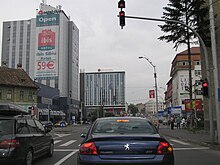
Due to investments worth millions from Austria and Germany, the city's economy has been in an unbridled upswing since the early 2000s, which is also due to growing tourism and construction investments in the old town and public infrastructure, both of which were very ailing after more than 50 years of communism. is fueled. The unemployment rate is below the Romanian average (4%) at below 3%. There is now a shortage of skilled workers; the city's commercial areas are busy. In general, the city has risen to one of the economically most prosperous centers in the whole country within just a few years and, together with Timișoara (Timisoara), Cluj-Napoca (Klausenburg) and the capital Bucharest, is one of the cities with the highest incomes in Romania. The pull of the city is now so great that no cheaper land and More to be given to investors - as happened in the case of Nokia in Cluj-Napoca. However, the administration is still actively helping with development and approval procedures.
Among others, the following companies are represented in Sibiu, which have settled in the "West" industrial park in the immediate vicinity of the airport :
- Bramac Group, the Austrian manufacturer of roof tiles, opened a production facility in the city on September 15, 2004 after a seven-month construction period. The company's headquarters were also relocated from Brașov (Kronstadt) to Sibiu.
- The Continental company with one production site: On July 22, 2004, a new factory for door control devices was put into operation; the foundation stone was laid in September 2003. A total of 216 jobs were created, 135 of them for development engineers.
- Greiner Group , packaging specialist from Austria.
- The company Marquardt system since 2006 has a manufacturing site in Sibiu.
- Metro with a large cash & carry market.
- The Schwarzach offset printing company with its Romanian subsidiaries Transilvania Pack & Print and Transilvania Microflute.
- Siemens AG currently has three plants (Simea, Siemens Electrical Installation Technologie, Sykatec) in which electromechanical components, metal components and electronic assemblies are manufactured. Around 400 employees currently work for Siemens in Sibiu. Over the next few years, more than 800 new jobs are to be created.
- Thyssenkrupp Bilstein Compa with currently 1800 employees, automotive supplier industry.
- The Swabian sensor specialist wenglor sensoric GmbH from Lake Constance, who was one of the first to come to Sibiu in 2001 and opened production and development in 2002.
- The Wienerberger company, the world's largest brick manufacturer, with the takeover and optimization of a brick factory: In March 2004 it was announced that it would invest 9 million euros in the location for this.
There are also branches of various other Austrian and German retailers and banks in the city ( Baumax , HVB , Kaufland , Lidl , OBI , Penny-Markt , Raiffeisenbank and others), as well as branches of other industrial companies such as Kromberg & Schubert . Hermannstadt is also the seat of the German Business Club Transylvania (DWS) and Sibex - Sibiu Stock Exchange , the second largest exchange in Romania.
education
More than 12,000 students study in 38 faculties in Sibiu. Around 12% of the population have a university degree. Notable educational institutions are e.g. B. Lucian Blaga University (with the Department of History, Cultural Heritage and Protestant Theology ), the Romanian-German University , the Orthodox Seminary, the Samuel von Brukenthal High School and the Pedagogical Lyceum.
Culture

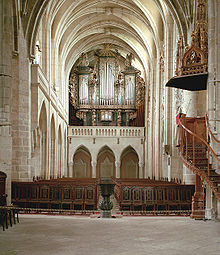
Sibiu has always had a reputation for being a cultural and spiritual center. The Evangelical Bishop of the Transylvanian Saxons and the Orthodox Metropolitan of Transylvania have their seat here. Two denominations (Evangelical / Lutheran and Orthodox) train their clergy here.
The first theaters and cinemas in Transylvania were in Sibiu. As early as 1788, the father of Martin von Hochmeister built the first theater in Sibiu. The first film screening took place on March 28, 1898.
Worth mentioning are the Astra Theater and the “Radu Stanca National Theater”, which has a German-speaking section.
Musical institutions today are the State Philharmonic, the Sibiu Bach Choir and the choir of Orthodox theology students.
Various festivals also take place in Sibiu every year, including the “International Theater Festival” and, from 1995, the “ Carl Filtsch Festival” piano and composition competition . The Sibiu Jazz Festival, Romania's oldest jazz festival, is located in Sibiu, and has been held there since 1974. The Pro Art Sibiu Foundation has been organizing the festival since 1992.
Restoration work is currently taking place on many buildings.
Museums
- Brukenthal Museum with the Brukenthal paintings collection
- Historical museum in the old town hall (Altemberger house, bourgeois Gothic architecture)
- Museum of the Evangelical Church A. B. in Romania (in the Friedrich Teutsch Culture and Meeting Center)
- Open-air museum of rural crafts (Muzeul Civilizației Populare Tradiționale Astra)
- Franz Binder Ethnological Museum (Muzeul de Etnografie universală Franz Binder)
- Steam locomotive museum (Muzeul Locomotivelor cu Abur) on the depot area of the Romanian State Railways (CFR) at the station area of the Sibiu Steam Locomotive Museum .
- August von Spieß Museum of Hunting Arms and Hunting Trophies
- Natural Science Museum, founded in 1895.
- Emil Sigerus Museum for Transylvanian-Saxon Folklore and Art.
Attractions
- Old Town Hall: The former seat of the city administration has an impressive inner courtyard. Today the historical museum is housed in the building.
- Astra building: The clubhouse of the Romanian club of the same name was built at the beginning of the 20th century.
- Bishop Teutsch monument between the Brukenthal Lyceum and the Protestant parish church
- Bishop's Palace of the Evangelical Church
- Böbelhaus: This building still shows the medieval shape of the Sibiu houses.
- Brukenthal Palace, one of the most important baroque monuments in Romania, built from 1778 to 1788 (see museums )
- Thick tower : Thefirst Hermannstadt theater was builton this bastion (part of the city wall ) in 1788. Concerts are held in the Thalia Hall on the Dicken Turm (up to 500 seats).
- Fingerlingsstiege leads to the right of the treasure chest from the upper to the lower town.
- Gheorghe Lazar monument on the Great Ring near the town hall (rebuilt in 2006)
- Großer Ring - the actual main square with many buildings worth seeing, completely refurbished since 2006
- Hallerbastei - an imposing part of the city wall , built under Mayor Haller (16th century)
- Hallerhaus: There is now a café in the former home of Mayor Haller
- Harteneckgasse with the guild towers on the city wall
- Huetplatz: This is where the Protestant parish church, the chapter house and the Brukenthal Lyceum are located.
- Kaiser-Franz-Monument - in the city wall, in front of the former Heltau bastion
- Kleiner Ring: A nice place with house facades that are well worth seeing, since 2006 completely renovated
- Bridge of Lies, cast iron bridge from 1859, which according to legend should collapse as soon as a liar steps on it.
- Lutschhaus - seat of the Democratic Forum of Germans in Romania (DFDR)
- Luxemburg House: The distinctive red building between Huetplatz and Kleiner Ring now houses u. a. Cafes and a hostel
- Pempflinger-Stiege - main connection from the upper to the lower town for pedestrians
- Ratturm - between the Big and Small Ring
- Treasure chest on the Kleiner Ring with a beautiful arcade
- Statue of St. John Nepomuk : The monument used to be in the middle of the Great Ring. After the transfer it is now in the inner courtyard of the Roman Catholic rectory.
Houses of worship
- Biserica din groapă (Church in the moat), Romanian Orthodox, built 1788/89
- Evangelical parish church , Protestant, built in the middle of the 14th century
- Evangelical Church Neppendorf, Protestant, built from the 13th century
- Franciscan Church , Catholic, built in the 15th century as a monastery of the Poor Clares
- Johanniskirche, Protestant, built in 1883
- Kreuzkapelle, catholic, on the station square
- Reformed Church, reformed, built in 1786
- Holy Trinity , Catholic parish church, built 1726–1733
- Synagogue , built in 1898/99
- Ursuline Church , Catholic, built in the 15th century (is also used today by the Greek Catholic community)
- Petrus and Paulus Church , built in 1788 by the Greek Catholic community (used by the Romanian Orthodox Church since 1948)
- Holy Trinity Orthodox Cathedral, Orthodox, built 1902-1906
Other structures
- Brukenthal Lyceum ; German grammar school and oldest school in town - since 1380
- German Cultural Center ; Opening on October 2, 2004. The Romanian-German Cultural Society of Sibiu is the sponsor
- Lucian Blaga University of Sibiu ; Very much appreciated by the local economy and therefore seen as a location advantage of the city. German professors read as honorary professors
- Stadium at the Erlenpark ; holds up to 20,000 spectators and is under renovation.
- Transsilvania multipurpose hall ; for up to 2,500 spectators (of which 1,812 seats)
- two Jewish cemeteries
Parks
- Alder Park, botanical garden from 1856 that is being revitalized
- Young forest, traditional local recreation area for the inhabitants. Romania's first zoo was founded here in 1928
European Capital of Culture 2007
Together with the City of Luxembourg , Sibiu was named European Capital of Culture for 2007 by the then 25 EU ministers of culture . Attempts to have the old town entered on the UNESCO World Heritage List have so far failed. However, the city made great efforts to promote the renovation of the old town. The results are u. a. the complete redesign of the Großer Ring (the central square of the old town), the Kleiner Ring and the Heltauer Gasse. Important historical buildings have been and are being renovated with funds from the EU, German federal funds and Romanian state funds.
media
- Ziarul de Sibiu (daily newspaper)
- Rondul de Sibiu (daily newspaper)
- Tribuna Sibiului (daily newspaper)
- Hermannstädter Zeitung , formerly "Die Woche", in German (weekly newspaper)
- Allgemeine Deutsche Zeitung , German-language daily newspaper
Sibiu is the city in which the first newspaper in Transylvania was printed in 1778, the Theatral Wochenblatt .
traffic

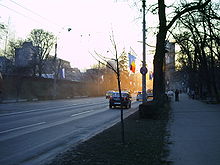
air traffic
The city has an international airport (Aeroportul Internațional Sibiu), from which direct flights to numerous European cities are offered. In 2007 the airport was expanded and modernized.
Public transport
The connection from Sibiu to the railway network is less advantageous. The line from Vințu de Jos (Unterwintz) to Brașov (Kronstadt) - where Sibiu lies - is not electrified; those from Sibiu to Mediaș (Medias) also not. A narrow-gauge railway , the so-called " Wusch ", used to connect Sibiu through the Harbachtal with Sighișoara (Schäßburg) . After it was only run as far as Agnita (Agnetheln) from the 1960s , the Romanian Railways ( CFR ) ceased operations in 2001.
The municipal company Tursib operates the bus routes in the city and in the suburbs. The Sibiu tram , which opened in 1905, also ran until 2011 , which in turn replaced the Sibiu Railway from 1904. Since 1970 the tram only consisted of an overland route from Cimitirul Central (main cemetery) to Răşinari (Reschinar) . This line was also called "cheese express" due to the professional specialization of the residents of Mărginimea Sibiului in the Rășinari. After the remaining wagons were handed over to the Rășinari municipality in 2012 and operations ceased, the line is to be reactivated for tourist purposes in mid-2014 with the help of EU funds. The rails were removed in Sibiu to Pădurea Dumbrava (Young Forest) ; in addition, a new depot must first be built in Rășinari. From 1983 trolleybuses also ran in the city, at times there were up to three lines, including to the airport. On November 14th 2009 the trolleybus traffic was finally stopped.
Trunk roads
Sibiu is connected to the international trunk road network via the European roads E68 (national road DN1 ) and E81 (national road DN7 ). Coming from Deva , these run on a route through the city and separate south of Sibiu in the direction of Brașov (Kronstadt) (E68 / DN1) and Wallachia (E81 / DN7). Another important road connection is the national road 14 to Mediaș and on to Sighișoara.
From 2006 to 2010, a large bypass was built, which has enclosed the city as a ring road since December 1, 2010 . This was originally intended to be part of the A1 Arad –Deva – Sibiu – Piteşti – Bucharest highway by 2014 . The subsequent sections of the route to Bucharest via Tălmaciu (Talmesch) , Curtea de Argeş and Piteşti, and to Timişoara (Timisoara) through the under forest towards Arad to Hungary , that between Marginea (Marschina) and Ilia (Elienmarkt) , should possibly be completed in 2023. These sections of the route are heavily used by the steadily increasing transit traffic.
Sports
Since the city administration concentrates more on cultural projects, there are few financial resources left for sport - the clubs survive with the help of private sponsors. Sports such as soccer, handball or volleyball are popular, but only in basketball are successes regularly celebrated at national level.
Football has an eventful history in Sibiu : on the one hand the traditional club Șoimii Sibiu (founded in 1910), which was only able to play in the first division for three years, on the other hand the more successful FC Inter Sibiu in the 1980s, which won the Balkan Cup in 1991 brought the last international cup to Romania. Both teams went bankrupt after 2000. A new club called FC Sibiu was founded in 2003, but two years later it narrowly missed promotion to the first division and was relegated to the third (amateur) division after the 2005/06 season. In 2007, a club was founded with CSU Voința Sibiu , which made it through from League IV to League 1 within three seasons (2008/09 to 2010/11) . In 2012 the association was dissolved. FC Hermannstadt , founded in 2015, will play in League I in the 2018/19 season .
The basketball club CSU Sibiu , which has a somewhat more glorious past (two championship titles), enjoys greater popularity . Due to a lack of financial support, however, the CSU has not been able to get involved in the title fight of the National League in recent years. The women's basketball team of CSU Magic Sibiu, on the other hand, plays in the midfield of the first division despite little experience.
The Sibiu Open , a men's tennis tournament that is part of the ATP Challenger Tour , has been taking place since 2012 .
For some years now, Martin Freinademetz has been organizing the Red Bull Romaniacs in and around the city , one of the most demanding enduro rallies in the world, which also attracts world-famous drivers. Sibiu itself acts primarily as a start and finish and the event is also very popular with the population.
There was also a lot of motor sport in Sibiu. This is where the teams from Voin IPa Sibiu and IPA Sibiu , which played an important role in the Romanian speedway , were based. There were also motocross races at Gușterița . In motor racing, Sibiu was a start and finish point for the Danube Rally .
Personalities
Connected with Sibiu
- Josef von Ringelsheim (1820–1893), military commander of Sibiu
- Jenny Rasche (* 1983), German social activist, lives and works in Sibiu
Honorary citizen (selection)
- Emil Constantinescu (* 1939), former President ( PNȚ-CD )
- Ștefan Augustin Doinaș (1922–2002), writer
- Emil Hurezeanu (* 1955), journalist
- Nicolae Iorga (1871–1940), historian, writer and politician
- Christoph Klein (* 1937), bishop emeritus of the Protestant regional church A. B. in Romania
- Andrei Marga (* 1946), former Minister of Education ( PNȚ-CD )
- Alois Mock (1934-2017), former Austrian Foreign Minister ( ÖVP )
- Paul Philippi (1923–2018), theologian and former chairman of the DFDR
- the revolutionary heroes of 1989
- Otto Schily (* 1932), former German Federal Minister of the Interior ( SPD )
Born or died in Sibiu
In alphabetic order
- Otto Ferdinand von Abensperg and Traun (1677–1748), Habsburg field marshal
- Dieter Acker (1940–2006), composer and musicologist
- Michael Gottlieb Agnethler (1719–1752), archaeologist and botanist
- Wolf von Aichelburg (1912–1994), writer
- Alexandru Apolzan (1927–1982), football player
- Arthur Arz von Straussenburg (1857–1935), Chief of Staff of the Austro-Hungarian Army
- Alexandru Barbu (* 1987), ski racer
- Mathias Beer (* 1957), Romanian-German historian
- Ján Levoslav Bella (1843–1936), Slovak composer, city choirmaster and conductor in Sibiu from 1881 to 1921
- George Bette, chemist, examined the salt springs at Bazna
- Heinz Birthelmer (1884–1940) General Director of Eisenstädter Elektrizitäts AG and politician (NSDAP) as well as NSDAP district economic advisor
- Miklós Borsos (1906–1990), sculptor and medalist
- Michael von Brukenthal (1716–1773), Transylvanian politician, royal notary, chairman and royal judge, chief captain of the Fagaras district
- Samuel von Brukenthal (1721–1803), governor of Transylvania
- Daniela Cârlan (* 1980), track and field athlete
- Emil Cioran (1911–1995), Romanian-French philosopher and writer
- Gustav Conrad (1875–1923), pedagogue, educationalist, orphanage director
- Gustav Adolph Conrad (1841–1903), forest scientist, natural scientist and local historian
- Victor Vlad Cornea (* 1993), tennis player
- Florin Cotora (born 1972), football player
- Alexandru Curtean (born 1987), football player
- Otto Czekelius (1895–1974), architect, civil engineer
- Dietmar Daichendt (* 1967), doctor
- Dan Dănilă (* 1954), poet and painter
- Gavril Dejeu (* 1932), politician and lawyer
- Gheorghe Dima (1847–1925), Romanian composer, after 1881 conductor of the Romanian music association in Sibiu
- Magda Draser-Haberpursch (1930–2016), handball player
- Iancu Dumitrescu (* 1944), composer
- Juliana Fabritius-Dancu (1930–1986), painter, folklorist and art historian
- Mihaela Fera (* 1970), ski racer
- Eugen von Friedenfels (1819–1885), administrative officer and historian
- Günter Fronius (1907–2015), inventor and entrepreneur, most recently the oldest living Austrian man
- Michael Fuß (1814–1883), Protestant clergyman and botanist
- Marius Gherman (* 1967), artistic gymnast
- Ilie Greavu (1937-2007), football player
- Guido Gündisch (1884–1952), Hungarian member of the Reichstag for the Transylvanian Saxons
- Conrad Haas (1509–1576), military technician and rocket pioneer
- Norbert von Hannenheim (1898–1945), composer
- Johann Sachs von Harteneck (1664–1703), Count of the Saxon Nation in Transylvania
- Johann Ernst Hintz (1845–1920), Transylvanian politician, member of the Hungarian Reichstag
- Michael Hißmann (1752–1784), philosopher
- Viorel Hizo (* 1947), football coach
- Franz Hodjak (* 1944), writer
- Steve Holmes (born 1961), porn actor
- Kurt Horedt (1914–1991), prehistoric
- Julius von Horst (1830–1904), Austrian major general and politician
- Emil Hurezeanu (* 1955), journalist
- Klaus Johannis (* 1959), President of Romania
- Richard Kepp (1912–1984), gynecologist and obstetrician , professor and from 1965 to 1966 rector of the Justus Liebig University in Giessen
- Christoph Michael Klein (* 1937), theologian, bishop of the Evangelical Church in Romania
- Hans Klein (* 1940), Evangelical Lutheran theologian, university professor and politician
- Károly Koller (1838–1889), Austro-Hungarian photographer
- Markus Krauss (* 1987), German soccer player and coach
- Petruța Küpper (* 1981), pan flutist
- Gheorghe Lazăr (1779–1823), Romanian educator, studied and taught at times in Sibiu
- Johannes Lutsch (1607–1661), Transylvanian politician, Count of the Saxon Estates in Transylvania
- Hermann Oberth (1894–1989), is considered one of the founders of scientific rocket technology and astronautics
- Leonhardus von Hermannstadt (around 1400), bell founder, artist and sculptor. He is the creator of eight historic baptismal font still in Medias , Sighisoara , Schaas , Henndorf , because the village and Kleinschelken are
- Nicolae Manolescu (* 1939), chairman of the Romanian Writers Union
- Johann Michaelis (1813–1877), educator and Lutheran pastor
- Marilena Neacșu (* 1961), artistic gymnast
- Radu Niculescu (* 1975), football player
- Steliana Nistor (* 1989), artistic gymnast
- Miklós Oláh (also Nicolaus Oláh or Nikolaus Olahus, 1493–1568), Hungarian archbishop, writer, politician and theologian
- Oskar Pastior (1927-2006), writer
- Dan Perjovschi (born 1961), artist
- Norbert Petri (1912–1978), musicologist and composer
- Paul Philippi (1923–2018), theologian and politician ( DFDR )
- Ronny Philp (* 1989), German soccer player
- Roland Phleps (1924–2020), German sculptor, neurologist and psychiatrist
- Helmut Plattner (1927–2012), organist
- Claudia Presăcan (* 1979), gymnast, Olympic champion
- Wolfgang Rehner (* 1962), Lutheran Superintendent of Styria
- Ludwig Reissenberger (1819–1895), meteorologist, art historian and educator
- Melitta Rühn (* 1965), artistic gymnast
- Andrei Șaguna (1809–1873), Romanian Orthodox prince and scholar
- Jens Scheiner (* 1976), Islamic scholar
- Eleonore Schikaneder (1751–1821), actress, singer and theater director
- Franziska Schlattner (* 1971), actress
- Ortwin-Wolfgang Schmidt (* 1944), handball player (13 international matches for Romania)
- Friedrich Schuler von Libloy (1827–1900), legal historian of the Transylvanian Saxons, rector of the Franz Joseph University
- Hanns Schuschnig (1927–2014), German theater director, translator and actor
- Paul Schuster (1930-2004), writer
- Friedrich Setz (1837–1907) Austrian architect
- Martin Siebenbürger (1475–1522), Mayor of Vienna
- Emil Sigerus (1854–1947), folklorist and city historian
- Dumitru Stăniloae (1903–1993), Orthodox theologian
- Mihaela Stănuleț (* 1967), gymnast, Olympic champion
- Brigitte Stephani (* 1942), folklorist, art critic, publicist, translator
- Karl Johann Stephani (1876–1930), agricultural scientist, author, publicist
- Nicolae Tătaru (1931–2001), football player and coach
- Georg Daniel Teutsch (1817–1893), from 1867 to 1893 Bishop of the Evangelical Church A. B.
- Friedrich Teutsch (1852–1933), parish priest in Sibiu from 1903, bishop of the Transylvanian Saxons
- Götz Teutsch (* 1941), cellist in Bucharest and Berlin
- Ferdinand Graf Tige (1719–1811), Austrian cavalry general and President of the Court War Council
- Edmund Uher (1892–1989), entrepreneur and inventor of the photographic typesetting system "Uhertype"
- Max Vogrich (1852–1916), pianist and composer
- Claus Voss (1929–2015), medical officer, inspector of the medical service
- Radu Vasile (1942–2013), politician ( PNȚ-CD )
- Erwin Wittstock (1899–1962), writer
- Carl Wolff (1849–1929), economist, journalist and politician
- Klaus Wolff (1935–2019), Austrian dermatologist
- Kalle Zeier (* 1983), fusion musician
Town twinning
-
 Bauru in Brazil , since 1995
Bauru in Brazil , since 1995 -
 Columbia in Missouri , USA, since 1994
Columbia in Missouri , USA, since 1994 -
 Klagenfurt in Austria , since 1996
Klagenfurt in Austria , since 1996 -
 Landshut in Bavaria , since 2002
Landshut in Bavaria , since 2002 -
 Marburg in Hessen , since 2005
Marburg in Hessen , since 2005 -
 Mechelen in Belgium , since 1996
Mechelen in Belgium , since 1996 -
 Rennes in France , since 1999
Rennes in France , since 1999 -
 Takayama in Japan since 2009
Takayama in Japan since 2009 -
 Thorigné-Fouillard in France (with district Hipodrom I )
Thorigné-Fouillard in France (with district Hipodrom I ) -
 Valencia / Carabobo in Venezuela , since 1993
Valencia / Carabobo in Venezuela , since 1993 -
 Wirral in the UK since 1994
Wirral in the UK since 1994
See also
literature
- Address book of the k. free city of Sibiu. Vol. 9, 1901, ZDB -ID 2632738-7 , urn : nbn: de: hebis: 30-1036238 .
- Hermann Fabini , Alida Fabini: Hermannstadt. Portrait of a city in Transylvania. Monumenta-Verlag, Hermannstadt 2000, ISBN 3-929848-17-1 .
- Cornelia Feyer: Brukenthals gardens. Splendor and decay in southern Transylvania. Schiller Verlag, Hermannstadt / Bonn 2008, ISBN 978-3-941271-02-9 . Romanian edition under the title: Grădinile lui Brukenthal. ibid 2008, ISBN 978-3-941271-11-1 .
- Arne Franke: Hermannstadt-Sibiu. An art history tour through the city on the Zibin (= Great Art Guide. Volume 231 = Great Art Guide in the Potsdam Library, Eastern Europe. Volume 1). With a historical introduction by Harald Roth . Schnell + Steiner, Regensburg 2007, ISBN 978-3-7954-2004-8 .
- Heinz Heltmann, Gustav Servatius (Hrsg.): Travel guide to Transylvania. Wort und Welt Verlag, Thaur near Innsbruck 1993, ISBN 3-85373-133-3 .
- Harald Roth : Sibiu. Little history of a city in Transylvania. Böhlau, Cologne a. a. 2006, ISBN 3-412-05106-3 .
- Johann Seivert : The Saxon city pastors to Sibiu. Barth, Sibiu 1777, digitized .
- Georg Soterius: "Cibinium". A description of Sibiu from the beginning of the 18th century (= writings on the geography of Transylvania. Volume 31). Edited from Neo-Latin and translated into German by Lore Poelchau. Böhlau, Cologne a. a. 2006, ISBN 3-412-21505-8 (Bilingual edition: Latin / German).
Web links
- Official website (Romanian, German, English)
- Official website for the European Capital of Culture 2007. In: sibiu2007.ro. Archived from the original on November 18, 2007 (Romanian, various mementos available).
- Sibiu Urban Renewal Foundation. (No longer available online.) In: sibiu2007.ro. Archived from the original on April 5, 2010 (Romanian).
- Sibiu at sevenbuerger.de
Individual evidence
- ↑ 2011 census in Romania. In: citypopulation.de, accessed on June 1, 2018.
- ↑ Postal ZIP code of Sibiu, Romania (Sibiu streets) - GeoPostcodes database . Retrieved March 22, 2015.
- ^ Fodor back in office . Retrieved August 17, 2019.
- ↑ Mayoral elections 2016 in Romania ( XLS ; 256 kB).
- ^ PUG 1999 - Municipiul Sibiu - Regulamentul local de urbanism , accessed on May 22, 2011 (Romanian).
- ^ PUG 1999 - Municipiul Sibiu - Unități Teritoriale de Referință , accessed on May 22, 2011 (Romanian).
- ↑ PUG SIBIU - Regulament local de urbanism (PDF; 18.2 MB), accessed on May 22, 2011 (Romanian).
- ^ Tribuna, April 28, 2011 , accessed May 22, 2011 (Romanian).
- ↑ a b Harald Roth: Hermannstadt. Little history of a city in Transylvania. Cologne 2006, p. 8.
- ↑ a b Harald Roth: Hermannstadt. Little history of a city in Transylvania. Cologne 2006, p. 18.
- ^ Harald Roth: Hermannstadt. Little history of a city in Transylvania. Cologne 2006, p. 5.
- ^ Harald Roth: Hermannstadt. Little history of a city in Transylvania. Cologne 2006, p. 8 f.
- ^ Harald Roth: Hermannstadt. Little history of a city in Transylvania. Cologne 2006, p. 38.
- ^ Harald Roth: Hermannstadt. Little history of a city in Transylvania. Cologne 2006, p. 29.
- ^ Ulrich Andreas Vienna: Transylvania - pioneering region of religious freedom: Luther, Honterus and the effects of the Reformation . Schiller Verlag, Hermannstadt / Bonn 2017, ISBN 978-3-946954-05-7 , pp. 9-16 .
- ^ Reformation city of Hermannstadt (Sibiu). Romania. United in confession. In: reformation-cities.org/cities, accessed July 1, 2018.
- ↑ 2011 census in Romania. ( XLS ; 1.3 MB) (No longer available online.) In: recensamantromania.ro. Archived from the original on March 27, 2019 ; Retrieved April 18, 2019 (Romanian).
- ↑ Szeben megye településeinek etnikai (anyanyelvi / nemzetiségi) adatai 1850–2002 In: kia.hu, November 9, 2010, accessed on April 18, 2019 (Hungarian; PDF; 582 kB; census, last updated November 4, 2008).
- ^ Evangelical Church in Romania ( Memento from March 9, 2008 in the Internet Archive ). In: evang.ro. March 4, 2008, accessed July 1, 2018.
- ↑ Erasmus and Schiller. Two German-language bookstores in Sibiu ( Memento from March 29, 2009 in the Internet Archive ). In: buechercafe.ro, accessed on July 1, 2018.
- ↑ Christian Schaudwet: The German car industry discovered Transylvania. In: wiwo.de. March 11, 2008, accessed June 1, 2018.
- ↑ EU states conjure up unity. In: zeit.de, May 9, 2019, accessed on May 13, 2020.
- ^ CC: Astrid Fodor becomes mayor of Sibiu. In: sevenbuerger.de. June 6, 2016, accessed June 30, 2017 .
- ^ RS: Jazz Festival in Sibiu. In: Transylvanian newspaper. April 29, 2008, accessed April 18, 2019.
- ↑ See the foundation's homepage. In: sibiujazz.ro, accessed on July 1, 2018 (Romanian, English).
- ↑ Web presentation of the Friedrich Teutsch meeting and cultural center of the Evangelical Church A. B. in Romania.
- ↑ Web presentation of the Franz-Binder-Völkerkundemuseum.
- ↑ Muzeul Locomotivelor cu Abur. In: cultura.sibiu.ro. Archived from the original on January 11, 2012 ; accessed on July 1, 2018 (Romanian, web representation of the steam locomotive museum).
- ↑ Web presentation of the August von Spieß Hunting Weapons Museum.
- ↑ Web presentation of the Natural Science Museum.
- ↑ Web presentation of the Emil Sigerus Museum.
- ↑ Experience the German language and culture up close. In: Kulturzentrum-hermannstadt.ro, accessed on July 1, 2018.
- ^ The Schäßburger Saxon Press from 1869 to 1900 ( Memento from July 19, 2011 in the Internet Archive ). In: schaessburg-net.de, accessed on July 1, 2018.
- ↑ Hannelore Baier: Electric - the end of an era that began in 1904. In: ADZ . January 23, 2014, accessed May 18, 2014.
- ↑ ADAC Reisen - Motorway openings accessed on October 28, 2019.
- ↑ Alex. Ștefănescu: Ștefan Augustin Doinaş. Biography. In: romlit.ro. Fundatia Romania literara, 2002, archived from the original on March 4, 2016 ; Retrieved July 1, 2018 (Romanian, Cuprins No. 16).
- ↑ Miklós Borsos. (No longer available online.) In: cultura.sibiu.ro. Archived from the original on September 4, 2017 ; Retrieved April 18, 2019 (Romanian).
- ↑ Gavril Dejeu in the Romanian Chamber of Deputies.
- ^ Nicolae Manolescu on the website of the Romanian Academy.
- ^ Johann Steiner: Top handball player Ortwin-Wolfgang Schmidt is 65. In: Siebenbürgische Zeitung. October 9, 2009, accessed October 15, 2012.





